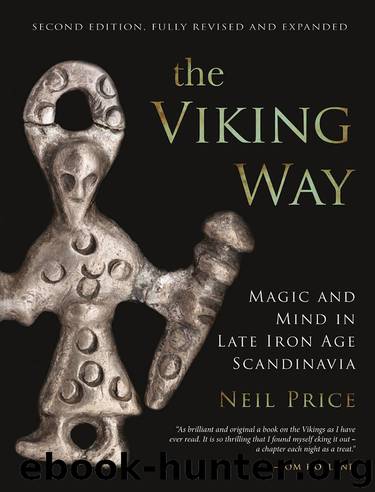The Viking Way by Neil Price

Author:Neil Price
Language: eng
Format: epub
Tags: HISTORY / Europe / Scandinavia
Publisher: Oxbow Books
Published: 2019-06-13T16:00:00+00:00
Julefolket and the dead-child tradition
One category of Sámi spirits is worthy of separate discussion here, due to their very close affinities with similar beings in Norse belief. These Julefolk, ‘Yule-people’, appear in some of the earliest sources, being found in Schefferus (1956 [1673]: 105) and in Leem (1767: 482) as the joulo-gazze. Today they are still known as javlla-stállo or rähttuna (Mulk 1998). These spirits were partly connected with the dead, and partly with other, less easily identifiable beings. They appeared during the Yule period, approximately between mid-November and early January, and always travelled in a large body, often in the form of a rajd (a sort of caravan formed of sleds, usually pulled by reindeer) drawn by mice and lemmings. Riding through the sky, the Julefolk would move around habitations at night, drawn by the sound of children playing. Appearing in the form of small humanoid figures, the spirits would then attempt to bear the children away on their mice-drawn sleds. For fear of the Julfolk, children were encouraged to be silent at this time, a feature common to other Sámi responses to dangerous spirits, such as those dwelling in the Northern Lights as discussed below.
In many ways these spirits have affinities with the ‘riders’ of Norse belief, especially in the context of the gandreið and similar phenomena mentioned in chapter 3, and the later folklore on the Wild Hunt of Óðinn (see chapter 6). Earlier writers such as Fritzner (1877: 157) identified the Julefolk directly with Óðinn, whom he believed to be synonymous with the leader of these spirits, a being called Jauloherra. Some support may be found for this, and indeed in the later medieval tales Óðinn’s riders are found by many names, some of which are very close to that of the Sámi spirits, for example the Jolaskreiði of western Norway (Aasen 1853: 27–8; de Vries 1957: § 167) and the Jolasveinar (Wang 1871: 9–10), the latter still current in Icelandic folklore. Óðinn himself was also identified in Ágrip (1) as the being behind the institution of Yule, through his name Jólnir.
However, it is more important to view the Julefolk alongside the Wild Hunt of Óðinn as yet another common feature in the ancient belief systems of northern Europe, in this case once again spanning both the Germanic and Finno-Ugric cultures.
Another category of these spirits among the Sámi was formed by the souls of children who had been exposed to die in the mountains, whose wails could be heard by travellers in the high country. Again, these have parallels in Nordic culture, and they are almost unique among the Sámi spirit beings in that a very considerable body of work has been specifically devoted to them. Pentikäinen’s classic thesis on the ‘dead-child tradition’ (1968) is still the most comprehensive study.
Download
This site does not store any files on its server. We only index and link to content provided by other sites. Please contact the content providers to delete copyright contents if any and email us, we'll remove relevant links or contents immediately.
| Africa | Americas |
| Arctic & Antarctica | Asia |
| Australia & Oceania | Europe |
| Middle East | Russia |
| United States | World |
| Ancient Civilizations | Military |
| Historical Study & Educational Resources |
The Radium Girls by Kate Moore(11967)
100 Deadly Skills by Clint Emerson(4876)
Rise and Kill First by Ronen Bergman(4739)
The Templars by Dan Jones(4656)
The Doomsday Machine by Daniel Ellsberg(4447)
The Rape of Nanking by Iris Chang(4165)
Killing England by Bill O'Reilly(3968)
Hitler in Los Angeles by Steven J. Ross(3923)
Stalin by Stephen Kotkin(3917)
12 Strong by Doug Stanton(3525)
Hitler's Monsters by Eric Kurlander(3289)
Blood and Sand by Alex Von Tunzelmann(3164)
The Code Book by Simon Singh(3126)
Darkest Hour by Anthony McCarten(3096)
The Art of War Visualized by Jessica Hagy(2972)
Hitler's Flying Saucers: A Guide to German Flying Discs of the Second World War by Stevens Henry(2730)
Babylon's Ark by Lawrence Anthony(2646)
The Second World Wars by Victor Davis Hanson(2502)
Tobruk by Peter Fitzsimons(2476)
